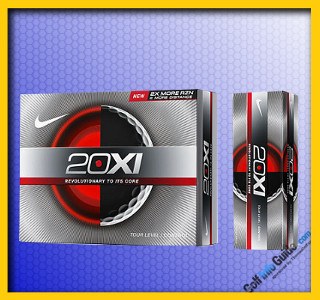
Ball tested: Nike 20XI-X
Category: Tour/Advanced/Performance
Specs: Construction – Four-piece; Cover – Urethane; Core – Resin; Dimples / Pattern – 360 in seamless design
Compression: High
Price as tested (new): $46 per dozen, but often available for less than $40
Ball notes: Is the second time the charm? That appears to be the case with Nike’s 20XI-X golf ball. Introduced in 2011 alongside the 20XI (and now-gone 20XI-S), the firmest of the trio met with rather mixed reviews. “It’s too hard,” cried some critics. “Where’s the spin?” asked others.
When Nike revamped the 20XI-X for 2013, it received far better grades. Golf Digest, in fact, awarded the ball a Hot List gold medal. The 20XI-X also earned a coveted spot in the bag of Rory McIlroy, as well as Nike stable mate Kyle Stanley and other pros.
How did Nike do it? By enlarging and softening the ball’s resin (or “RZN”) core. Let’s see how the new model fared in our tests.

Sound and feel: While we had limited experience with the original 20XI-X, the 2013 version certainly seems softer. It’s still got a little “click” you won’t feel in other “tour” balls, including the 20XI, but it wasn’t a deal breaker in our book.
Off the tee: It’s hard to discern much difference between tour models in the distance department; the 20XI-X falls in line with its siblings and competitors. However, flight was noticeable straighter with this ball. The best comparison may be to Bridgestone’s e6. The vast majority of golfers will consider this a major plus, though a few highly skilled players may prefer a ball that’s easier to work left and right. At any rate, the 20XI-X is a great wind ball with a stable, penetrating trajectory.
From the fairway / rough: Improved backspin? Yes. Top of the heap? No. Then again, the 20XI-X is designed for distance and accuracy, so we expected it to come up a little short on the spin meter. Well-struck shots won’t bounce wildly off the green, mind you. But they may not bite as hard as you want, either. That could be a feature, not a bug, for players who generate lots of spin.
Once again, the 20XI-X performed beautifully when hit into a headwind or crosswind.
Around the green: No, it doesn’t magically transform into a hyper-spinning, super-soft orb on chips and pitches. Yet the 20XI-X shouldn’t cost you short-game strokes, either. It offers adequate control on chips and bunker shots, though slightly less than Nike’s other tour model.
Bottom line: You got a problem with long and straight? If not, you’ll like the 20XI-X. Old-school shotmakers and spin-meisters might want to look elsewhere for the maneuverability and control they covet. Still, there’s no denying the progress Nike made with this ball from one generation to the next. Who knows what the future may bring?
Golf Ball Videos:
– Compression Video
– Spin Video
– Dimples Video
– Golf Ball Brands Video
– Titleist Video
– Understanding Spin Video
Categories Explained:
Value/Recreational/Distance – Designed for mid- to high-handicap golfers with swing speeds below 90 mph; typically feature two-piece construction and firm covers; promote greater distance over high spin rates. Examples: Pinnacle Gold, Slazenger RAW Distance
Premium – Designed for low- to mid-handicap golfers with swing speeds of 90-99 mph; typically feature multi-layer construction and medium-soft covers; happy medium between Value/Recreational and Tour categories for distance and spin qualities. Examples: Titleist NXT Tour, Callaway HEX Diablo
Tour/Advanced/Performance – Designed for low-handicap and professional golfers with swing speeds in excess of 100 mph; typically feature multi-layer construction and soft covers; promote greater spin rates and enhanced feel over distance. Examples: Titleist ProV1, Bridgestone Tour B330





